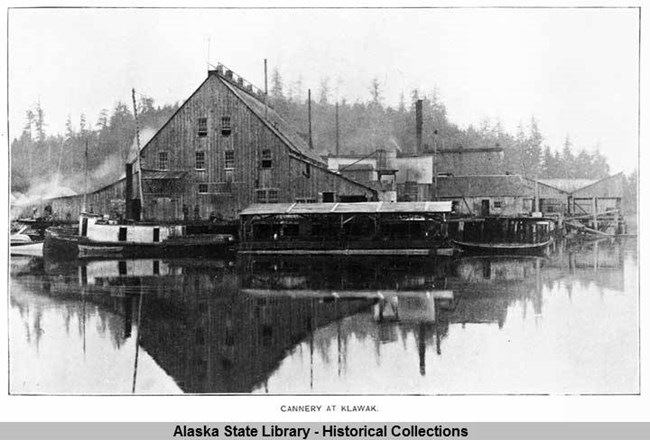Part of a series of articles titled Canneries of Alaska.
Article
Canneries of Alaska
The first commercial fishing operations in Alaska were factories where fish were salted before being sent to outside markets. These salteries were converted into canneries where fish were processed and canned. The canneries became boom and bust towns, functioning at full capacity during the salmon run and becoming a ghost town the rest of the year.
These industrial developments began popping up along the coasts, with many near areas that are now part of the National Park System. These sites became self-sustaining communities. In addition to warehouses and processing buildings used for the canning operation, these sites often had bunkhouses, mess halls, some single-family homes, stores, laundry, hospitals, and jails. In certain cases, villages were developed adjacent to the cannery, and churches and cemeteries were constructed. During the winter months, a single caretaker would often stay behind to manage the store and maintain the buildings.
The Cannery Landscape
Native Alaskan peoples had been using the areas that became occupied by the salteries and canneries for millennia as villages or seasonal encampments. While the development of the commercial canning industry altered the use and appearance of these landscapes, traditional subsistence practices continue to endure in Alaska.Features of the canneries were built in response to their environment. An ideal cannery site required an adequate freshwater source, space that was buildable, and an abundance of salmon and salmon streams. Many were constructed in drainages or directly on the shoreline, requiring the addition of boardwalks for circulation around the sites. The processing buildings were often built on pilings so they could extended out into the tideline and connect with docks. The design of the buildings and structures themselves was utilitarian in nature, and often an imposing feature to the landscape. In many cases, the cannery would be the only development in the area.

From Jefferson Moser's "The Salmon and Salmon Fisheries of Alaska," plate 44
The overall period of significance for canneries in Alaska begins in 1878, when the first two canneries opened, and ends in 1936, when salmon production peaked at 130 million. The overall commercial catch decreased significantly between the 1930s and the mid-1970s. Between 1878 and 1950, 134 canneries were constructed in the state, 65 of which burned. By the end of 1950, only 37 were in operation.
Salmon production remained low into the 1970s. In 1980, salmon production reached 110 million, increasing to 154 million at the end of 1980. Production continued to increase into the 1990s to 218 million. This increase in production is due to a successful management process led by Alaska Department of Fish and Game and the active role of the public. Regulating fish runs and the tools used to fish contribute to the sustainability of the seafood industry. Today, there are roughly 60 operating canneries.
Gorelick, Jeffrey. "The Eleventh Hour for Alaska's Salmon Fishery: A Proposed Regulatory Solution." Ecology Law Quarterly 3, no. 2 (Spring 1973): 391-93. doi:10.15779/Z380R6V
King, Bob. Sustaining Alaska's Fisheries: Fifty Years of Statehood. State of Alaska. Alaska Department of Fish and Game. 2009Last updated: November 5, 2019


